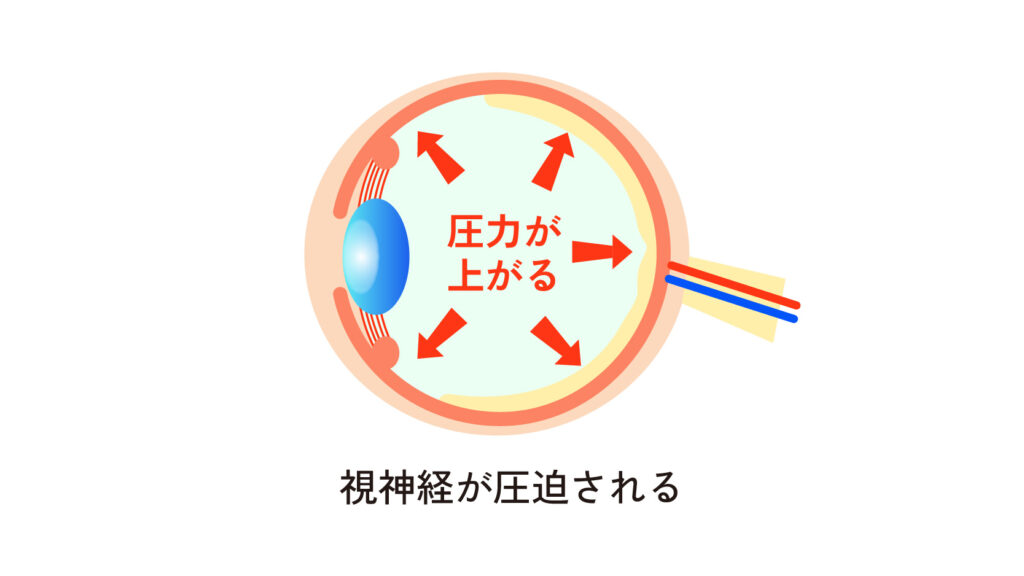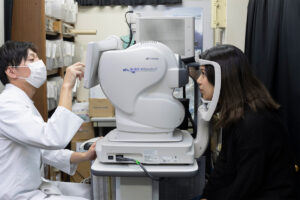Glaucoma is a disease that has no noticeable symptoms and is difficult to detect early. However, the incidence rate is high, with one in twenty people over the age of 40 and one in ten people over the age of 60 suffering from the condition, and it is also the leading cause of blindness among Japanese people. This page explains the causes of glaucoma, how it affects vision, and the types of treatment and tests available.
table of contents
【東京・池袋】緑内障の原因・症状・治療方法・手術
What is Glaucoma?

Glaucoma is a disease that damages the optic nerve and narrows the field of vision. It progresses very slowly, and the field of vision gradually narrows. It often progresses one eye at a time. Therefore, it is a disease that has almost no subjective symptoms and is difficult to detect early.
Image of vision in glaucoma

From the early to mid-stages, some parts of the field of vision become gradually harder to see, narrowing the field of vision. However, because both eyes can complement each other, it is difficult to notice until the condition has progressed significantly. By the time symptoms become noticeable, the area of vision may be significantly narrowed, and in some cases, the patient may be barely able to see at all.
Causes of Glaucoma
Glaucoma occurs when the eye nerves cannot withstand the intraocular pressure (eye hardness). Intraocular pressure varies depending on the amount of fluid (called aqueous humor) in the eye.
Glaucoma is divided into several categories based on the factors that change the amount of aqueous humor.
- Primary open-angle glaucoma
- Normal Tension Glaucoma
- Primary angle-closure glaucoma
- Pediatric Glaucoma
- Secondary glaucoma
Symptoms of Glaucoma
In the majority of cases of glaucoma, there are no noticeable symptoms at all in the early stages because damage to the optic nerve occurs slowly and the field of vision (range of vision) narrows little by little.
At our clinic, it is usually discovered in patients who visit for other reasons, such as contact lens prescriptions, hay fever, or cataracts.
Once the optic nerve is damaged, it cannot be restored, so it is important to detect it early and prevent it from worsening any further. There is also acute glaucoma, in which intraocular pressure rises suddenly, causing severe symptoms such as eye pain, headache, nausea, and blurred vision. In such cases, there is a risk of blindness, so immediate treatment is required.
Glaucoma treatment process
Glaucoma cannot be cured completely because the optic nerve once lost cannot be restored.
The treatment of glaucoma is based on lowering intraocular pressure to protect the optic nerve and prevent further narrowing of the field of vision.
If glaucoma is diagnosed during a medical examination, and the condition is mild, eye drops will be prescribed first. The aim is to control intraocular pressure with eye drops. The patient will be monitored for a certain period of time with eye drops, and if the condition does not improve with eye drops, surgery or laser treatment will be performed.
Glaucoma Testing
Glaucoma is diagnosed from a multifaceted perspective after undergoing several tests. The following tests are mainly used to diagnose glaucoma.
- Intraocular pressure measurement
- Goniometry
- Fundus examination
- OCT scan
- Visual field test, etc.
Intraocular pressure measurement
Intraocular pressure is measured using a tonometer, which temporarily indents the surface of the eye by blowing air on it.
If the intraocular pressure is high, the indentation will return to its original state in a short time, but if the intraocular pressure is low, it will take longer to return to its original state. The intraocular pressure is measured by measuring the time it takes for the indentation to return to its original state. Since only air is applied to the eye, it is gentle on the eyes and causes little discomfort.
Goniometry
Gonioscopy is a test to check whether a person is prone to angle-closure glaucoma. By looking at the condition of the angle, it is possible to determine whether a person needs laser treatment for glaucoma. It is also useful for diagnosing uveitis, which is inflammation of the iris, ciliary body, and choroid.
Fundus examination
Fundus examination is an examination that uses a special lens to directly view the inside of the eye, such as the retina at the back of the eye, the entrance and exit of the optic nerve, blood vessels, etc. It is also used to examine eye diseases such as cataracts and glaucoma, as well as internal diseases such as high blood pressure, arteriosclerosis, and diabetic retinopathy.
OCT scan
OCT is a test that uses a device called an optical coherence tomography to take a cross-section of the retina. It allows for the observation of cross-sections of the retina, something that could not be done with regular medical examinations or fundus examinations, and allows for more accurate diagnoses of retinal diseases and macular lesions.
Visual field testing
A visual field test is a test that measures the range of vision when looking straight ahead and the sensitivity of the retina. The presence or absence and size of visual field defects (range of vision loss) are used to determine the progression of glaucoma. This is an important test not only for diagnosis, but also to confirm and understand the effectiveness of treatment.
Types of Glaucoma Treatment
eye drops
Eye drops that are often used to treat glaucoma are used to lower intraocular pressure. Side effects include "redness of the eye," "eye discomfort," and "eye pain." Also, if intraocular pressure can be properly controlled with eye drops, it is possible to maintain vision and visual field without deterioration. Please be sure to follow the prescribed frequency and type of eye drops.
SLT (Selective Laser Therapy)
This is a treatment to lower intraocular pressure in patients with primary open-angle glaucoma, the most common type of glaucoma. The human eye is naturally equipped with a function to promote the outflow of aqueous humor (which serves to supply nutrients to the cornea and lens) from within the eyeball. SLT is a treatment to lower intraocular pressure by improving this function using laser energy when it has been impeded for some reason.
Cost of Glaucoma Surgery
The cost is 10% of the cost, about 9,000 yen
Approximately 27,000 yen with 30% copayment
The official name is "goniophotocoagulation" and benefits may be available from life insurance and medical insurance.
Benefits of Laser Glaucoma Treatment
A laser treatment called SLT (selective laser therapy) is used for glaucoma. The benefits of SLT laser treatment are as follows:
- Treatment time is short (only 10 minutes or so)
- Highly safe (no side effects)
- Can be used in combination with other treatments
- Can be treated repeatedly
SLT is a safe and gentle treatment that does not harm the body. The power of the laser used in SLT is extremely low, about 1/6000 of that of conventional laser treatment, so there is almost no pain and no damage to the eye. By undergoing SLT, the burden of using eye drops for a long time and the risk of forgetting to apply them may be reduced. SLT only evaporates the cell debris that is stuck in the trabecular meshwork filter, so the trabecular meshwork itself is not damaged, and if the filter becomes clogged again and intraocular pressure rises, "the treatment can be repeated as many times as necessary." In addition, since it is performed on an outpatient basis, hospitalization is not required.
Disadvantages of laser treatment for glaucoma
Although there are no major risks or disadvantages to SLT laser treatment, it may not be suitable for some glaucoma symptoms or progression. In such cases, other treatments, such as surgery, may be required.
Glaucoma treatment testing equipment
OCT scan
Intraocular pressure testing
Fundus examination
Visual field testing
【東京・池袋】緑内障の原因・症状・治療方法・手術の治療に関するよくある質問
Can anyone receive SLT?
SLT is most commonly used in Japanese people for open-angle glaucoma, but it is not effective for all patients. It is said to be effective in about 70% of patients, but the final decision is made by an ophthalmologist.
How is SLT performed?
Before the treatment, we will administer eye drops to anesthetic the eyes, and use a slit lamp and special lenses, just like during the examination. During the treatment, you will hear a series of clicking sounds, which are the sound of the instruments operating.
How long does SLT treatment take?
The procedure varies depending on the patient's symptoms and the area of treatment, but it usually takes about 10 minutes.
Is SLT painful?
This treatment stimulates cell-level action and is performed at extremely low power. Unlike previous laser treatments, most patients do not feel any pain.
Does SLT require hospitalization?
It is an outpatient procedure, so hospitalization is not required.
Does SLT have any side effects?
The only side effect reported is a mild stinging sensation in the eyes. If you experience this, your eye doctor may prescribe eye drops. This usually goes away on its own within a day or two.
Will I no longer need to use eye drops after having SLT?
You will need to return for a follow-up visit to assess how effective SLT was in lowering your eye pressure, and your eye doctor will determine your future eye drops.
Can I have SLT again?
Unlike other laser treatments, SLT is extremely safe and can be repeated. When no effect is seen after treatment, an ophthalmologist will decide whether to repeat SLT.
How much does SLT cost?
Like conventional laser treatments, it is covered by insurance.
What are the early symptoms of glaucoma?
What are the early symptoms of glaucoma? In the early stages of glaucoma, you are almost always unaware. If it is only temporary, it may just be fatigue, but if the following symptoms persist for a long time, you should see an ophthalmologist.
- My eyes are blurred
- I feel dazzled
- I see things twice
- Decreased vision
How long should I use eye drops for glaucoma?
Glaucoma is a condition in which the optic nerve is crushed by the current intraocular pressure. Pharmaceutical companies have prepared combination drugs with two or more effects to reduce the burden on patients and increase the effectiveness, but these drugs must be used for a long time to maintain low intraocular pressure.




